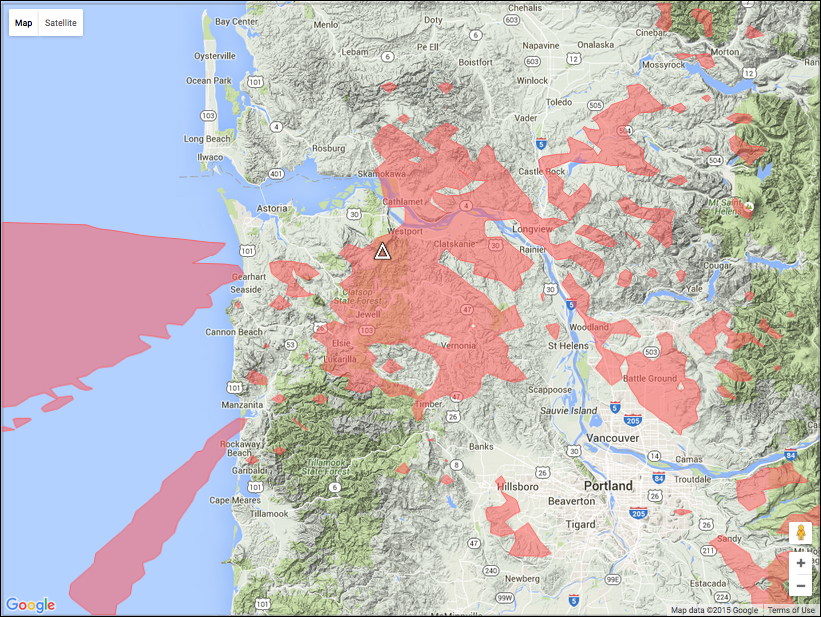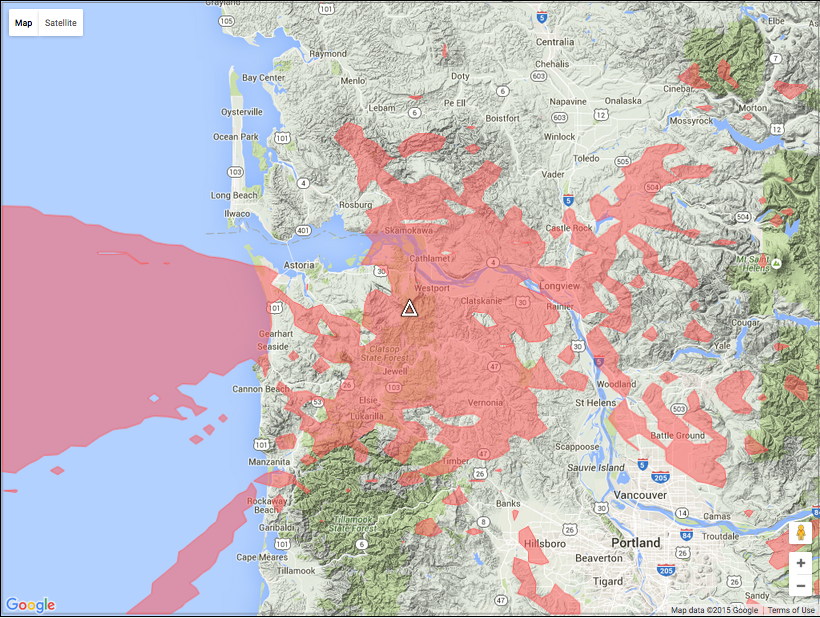Nicolai Mountain
Clatsop County, OR
46.08625, -123.45217
3007 Feet
Call: WA6TTR
444.500 +5MHz 118.8Hz

Nicolai UHF Repeater

Nicolai Packet Station
Site runs on batteries,
kept charged by solar
panels and a propane-fired
generator as needed. The
sun keeps things working
fairly well during the
summer months, but needs
some help come winter.
At times the link may be
down or the repeater un-
available to conserve
power. Our options are
limited with regard to
addressing this.
Please bear with us.
|
Location: The Nicolai Mountain radio site is
about ten miles of rough logging roads south of
Bradley Summit (Bradley Overlook State Park wayside) on
Oregon Highway 30, a few miles west of Westport, Oregon.
The ridge rises to the south with
the
radio site itself, at 3000-feet elevation,
perched on the sheer southern
face of the mountain, overlooking
Jewell, Mist, Vernonia,
and the Nehalem River Valley. The vantage into
Longview/Kelso is good, as well as into some parts of
the Portland Metro area. The land is
part of the Clatsop State Forest,
under the supervision of the Oregon Department of Forestry (ODF).
Coverage: Nicolai anchors
the southeast corner of
our service area, including the Longview-Kelso area,
north along Interstate 5,
well into the overlap with the
Olympia and KO Peak repeater coverage, and south to Woodland.
The Nicolai repeater is usable
along WA Hwy 4, from Longview, to
Cathlamet and westward, where it
overlaps the coverage with other
BeachNet
repeaters. The Nicolai repeater
is usable on Oregon Highway 53 in the Nehalem River Valley,
into Nehalem, Wheeler and Manzanita. Parts of Oregon Highways
26 and 30 are covered, and it can be
used in a few parts of the Portland/Vancouver area, as well as
east up the Columbia
Gorge, if you pick your spot carefully.
Affiliated with the
BeachNet
system, the Nicolai repeater
is owned by Gordon, WA6TTR, with substantial donations by NM7R and others.
It is primarily intended to provide
emergency communications in
Wahkiakum County and the rest of
ARES/RACES District Four (Wahkiakum, Cowlitz, Clark and
Skamania Counties). During emergency situations, drills/exercises
and at other times, the Nicolai
repeater may be taken off the
BeachNet
network for
use by District Four or Wahkiakum County.
Originally, there was a
wooden
forestry lookout tower
on the site. In the mid 1980's, this structure (encrusted in
antennas and feedlines) had fallen into disrepair, and was
rickety enough to be condemned. All the users were given
one year to remove their antennas. The State Forestry Department
erected a steel tower, and rented space on it. Several tenants
provided their own poles to avoid paying for tower space.
The old lookout tower is now long
gone, replaced by a
new
steel tower.
Hardware: The repeater
consists of a
GE Mastr-II 110-watt
continuous duty
station-style (running 40-watts),
with an Arcom RC-210 controller in a
44-inch GE cabinet.
The duplexer is a Decibel
Products 4-cavity
bandpass-notch type feeding a
9 dBd omni-directional vertical
antenna through 50 feet
of half-inch hardline.
The repeater antenna was originally
mounted atop the
30-foot
Rohn-25 tower,
but was moved to the
larger
state
tower when Amateurs were relieved
from having to pay a rental fee to do so.
There is a UHF GE Rangr mobile
incorporated as a link transceiver,
with a 6-element Yagi antenna
mounted on the short tower.
Also tucked into the cabinet is a
packet station using
a 2-meter Kenwood radio, with a VHF
bandpass cavity, feeding
a 3dBi vertical on a pole
next to the building.
Station Power:
The never-very-reliable
commercial power
line to the site
failed for the last time
in 2010, with Oregon Department
of Forestry unable to replace the
failed buried cable.
Clatsop County
picked up the slack with their
diesel generator until December,
2011, when they shut off the
juice, removed their generator
along with their radio gear,
and abandoned the adjacent
building.
Our landlords (fortunately)
wanted to stay. We came up with a plan
to provide power to their (our) site.
We already used a 1700-Amp-Hour
battery bank to run the station, in order to cover
for the never-very-reliable power line outages.
To this we added
a
5-kW propane-fired generator
in the building,
modified to include
a home-brew control
system allowing us to operate
the generator remotely,
using commands, and audible feedback
over the UHF repeater. This
charges the battery
bank through two 80-Amp chargers.
With no other power input, the generator
can normally replace the daily draw on the battery bank in an
hour or two.
Our original plan included solar panels, but we recognized a generator would
still be needed for days when the solar input
was inadequate. So, the generator came first.
In August of 2015 we finally installed
a
pair of solar panels
on the small Rohn tower to
provide a base charge, and
capitalize on the open
southern exposure, taking some
of the
strain off the generator.
In the summer months
on full-sun days
the panels are enough to operate
the station and keep the batteries charged.
In 2017 a second pair of solar panels was added.
The 4 panels are each 250-Watt rated, so on a full-sun
day the battery bank has a kilowatt available at 14-volts
to operate the station and charge the batteries. For the
summer half of the year, here at
46-degrees-north, our summer days can be very long, so
the generator is not really
needed.
The winter half of the year is a different story.
Between the short, dark days with the sun low in the sky,
and heavy overcast, rain and snow, which can
build up on the panels, the generator is needed
about every-other day or so, for a couple of hours to keep the batteries
charged, depending on how heavily the station is used. The site is
typically snowed in fairly heavily (4 to 6-feet or more) in winter, sometimes for
several months. This makes visits to provide regular service to the
generator a bit difficult, so in 2018 a second, stand-by generator
was installed so that in the event the primary failed to work
during one of these periods, a secondary power source would be
available to keep the station operating.
The load primarily consists of our UHF
repeater, VHF packet
node, an APRS node, our
landlord's commercial low-band-VHF
repeater, which
seasonally supports commercial logging operations
in the verdant timberlands surrounding
the site, and another UHF commercial low-power repeater.
There is also a 125VAC power line to the adjacent building
(hot whenever our generator is running) where
the Sunset Empire Amateur Radio Club
maintains the following
equipment on a separate battery bank with their own soar panels:
224.280 (-1.6; 103.5Hz) [part of the K5IN
linked network in SW Washington]
146.760 (-600; 118.8Hz) [part
of the "Sunset Empire ARC"
linked network in NW Oregon]
52.810 (-1.7; 100.0Hz) [part
of the "Region7Sixers" linked network in NW Oregon]
Power Priorities:
Our top priority is to not kill the batteries.
They are a sizable investment and
without them, the station is completely dead.
We will shut everything down, to save the batteries.
After the batteries, our
UHF repeater receiver and repeater controller are the next priorities.
We need them
to command the controller to tell us voltages, temperatures
and other data and to turn other things back on.
Matters would have to be truly dire for us to shut that receiver off,
because it would then require a physical site visit to regain control
of the station.
Next in line is the "the Logger's" repeater.
It's their
hut, after all, and keeping them on the air is the real price of "free rent".
We babysit the power system to keep
their station on the air, in exchange for rent-free use
of their building for our own gear.
They even pay for the propane to run the generator.
The transmitter of our repeater would be next in line. Obviously, the transmitter
uses significantly more power than the receiver.
We also have a link radio that couples this station into
BeachNet
that can
be shut off to conserve power. This isolates this repeater from the network,
but keeps from using power only to unnecessarily repeat traffic on other repeaters in
the system, which can be a significant power use if it is unnecessary to
have this repeater as part of the conversation.
After that are the packet node, APRS node and the UHF (commercial) repeater.
Site Cameras: There are three video cameras
at the site to keep an eye out for weather conditions and general site
security. Click here and
scroll down to the bottom three images. Due to site conditions
beyond our control, these may not always be available.
There are no lights at the site, so during hours of darkness there will
be no images available.
Packet Radio:
The "NICOLI"
packet
radio node is located at this site.
This
is part of the 145.630
MHz 1200-Baud Washington
Coastal EOC Packet Network.
This node is primarily intended
to extend the range of this network of Western
Washington high-level nodes. The
packet station
also has a telemetry
beacon (every half-hour when
activated) that reports
the battery
voltage from the site.
This provides a long-term log record
of battery voltage for those who
monitor the health of the system,
to augment the instantaneous voltage
reading always available over the
UHF repeater.
|